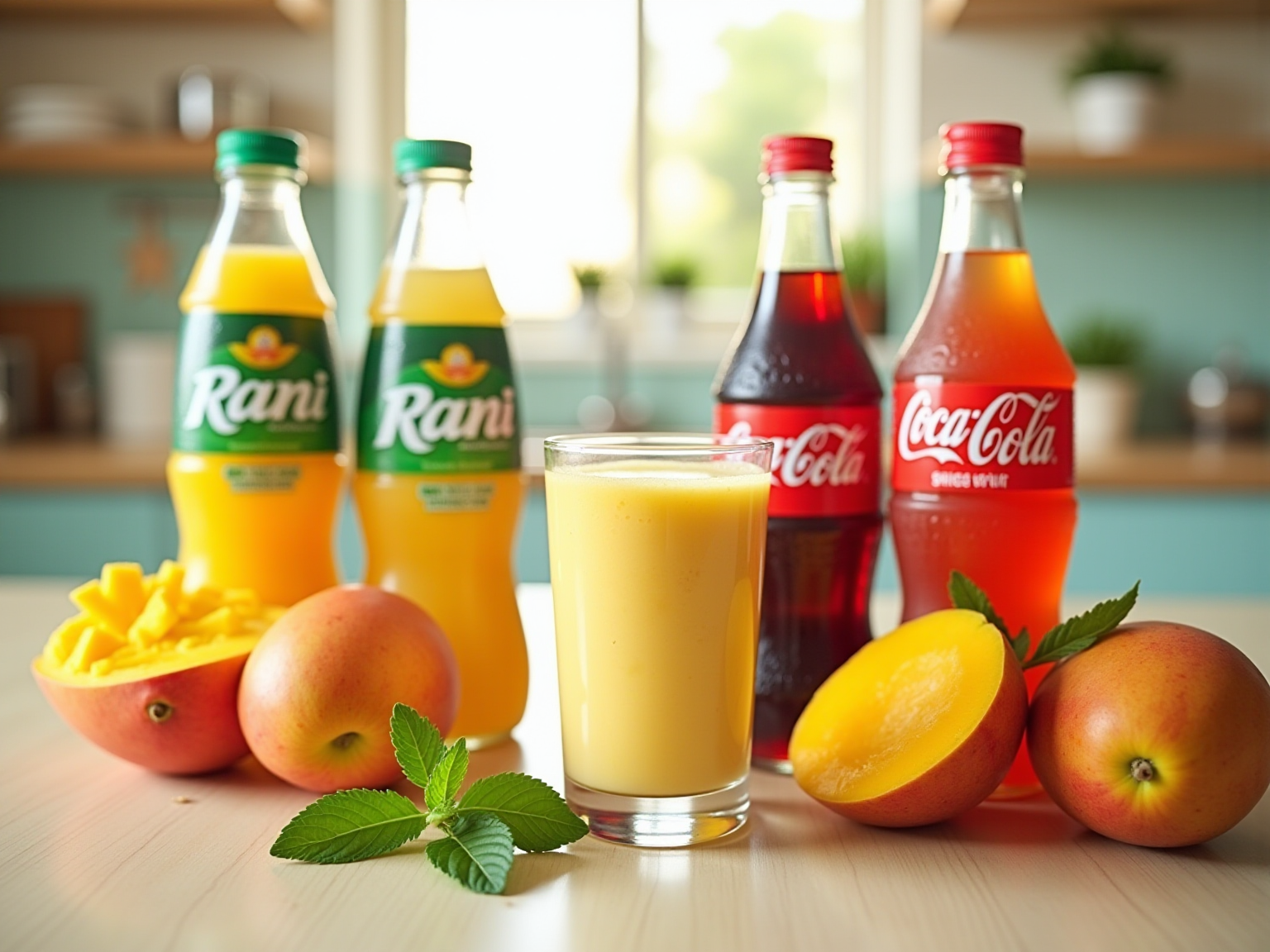General
Understanding 2024 Graphic Designer Compensation in the Food and Beverage Sector: A Complete Tutorial
Overview
The article provides a comprehensive analysis of the compensation landscape for graphic designers within the food and beverage sector for 2024. It outlines a salary range that is significantly influenced by factors such as experience, location, and industry demand. Specialized skills, employment types, and benefits are examined as critical elements that shape salaries. This analysis underscores the necessity for continuous skill development and networking, positioning these strategies as essential for designers aiming to maximize their earning potential.
Introduction
In the dynamic realm of food and beverage, graphic designers assume a crucial role in defining brand identities and shaping consumer behavior through impactful visual narratives. Their expertise transcends mere aesthetics; they meticulously craft packaging, menus, and promotional materials that resonate with the ever-evolving preferences of consumers. As the industry adapts to shifting eating habits and trends, the need for adept designers capable of articulating a brand’s essence becomes increasingly vital.
This article explores the diverse responsibilities of graphic designers in this sector, examines current compensation trends, and underscores the essential skills required to excel in a competitive market landscape. By providing insights into salary variations, employment types, and the importance of professional development, it delivers a thorough overview for designers aspiring to elevate their careers and leave a lasting imprint on the food and beverage industry.
The Role of Graphic Designers in the Food and Beverage Industry
Visual artists in the culinary and beverage sector play a crucial role in crafting visual narratives that convey brand identity and engage consumers, significantly influencing the 2024 graphic designer compensation in this industry. Their multifaceted responsibilities include:
- Designing packaging
- Menus
- Promotional materials
- Digital content
All aimed at attracting customers while encapsulating the brand’s essence. Indeed, effective graphic design can sway consumer choices, making it an indispensable element of marketing strategies, particularly as we consider the evolving landscape of eating habits leading into 2024.
Understanding culinary trends, consumer preferences, and branding principles is vital for designers, especially when reflecting on the 2024 graphic designer compensation in the food and beverage sector. This knowledge enables them to produce engaging visuals that resonate with target audiences. A recent study highlighted the significant impact of visuals on packaging in shaping consumer recognition and expectations. It revealed that products paired with visuals aligned with their significance, such as ‘fire’ imagery for spicy dishes, were identified more swiftly by consumers, showcasing the cognitive effects of design choices.
This insight is especially pertinent as brands recalibrate their advertising strategies to align with shifting consumer behaviors and preferences.
Moreover, successful visual design projects, like the brand identity uplift for Castania and the digital campaign for Motorola, illustrate how strategic visual elements can yield measurable outcomes. These case studies underscore the importance of visual artists in enhancing brand visibility and consumer interaction within the culinary and beverage sector, particularly concerning the 2024 graphic designer compensation and the dynamic market conditions. Furthermore, effective media planning and content creation strategies are essential for maximizing the impact of these visual narratives across diverse platforms, including social media and traditional advertising channels.
As Jessica Rather, an artist and illustrator, aptly states, “I believe we all desire another person’s career journey, but it’s essential to concentrate on working hard and simply doing the tasks needed to advance to the next level.” This perspective reinforces the notion that visual creators not only shape consumer perceptions but also play a pivotal role in the broader marketing landscape of the culinary and beverage industry, fostering sector growth through guidance and support for emerging talents. At WonderEight, we recognize the critical role of visual design in navigating these shifts and enhancing brand strategies.
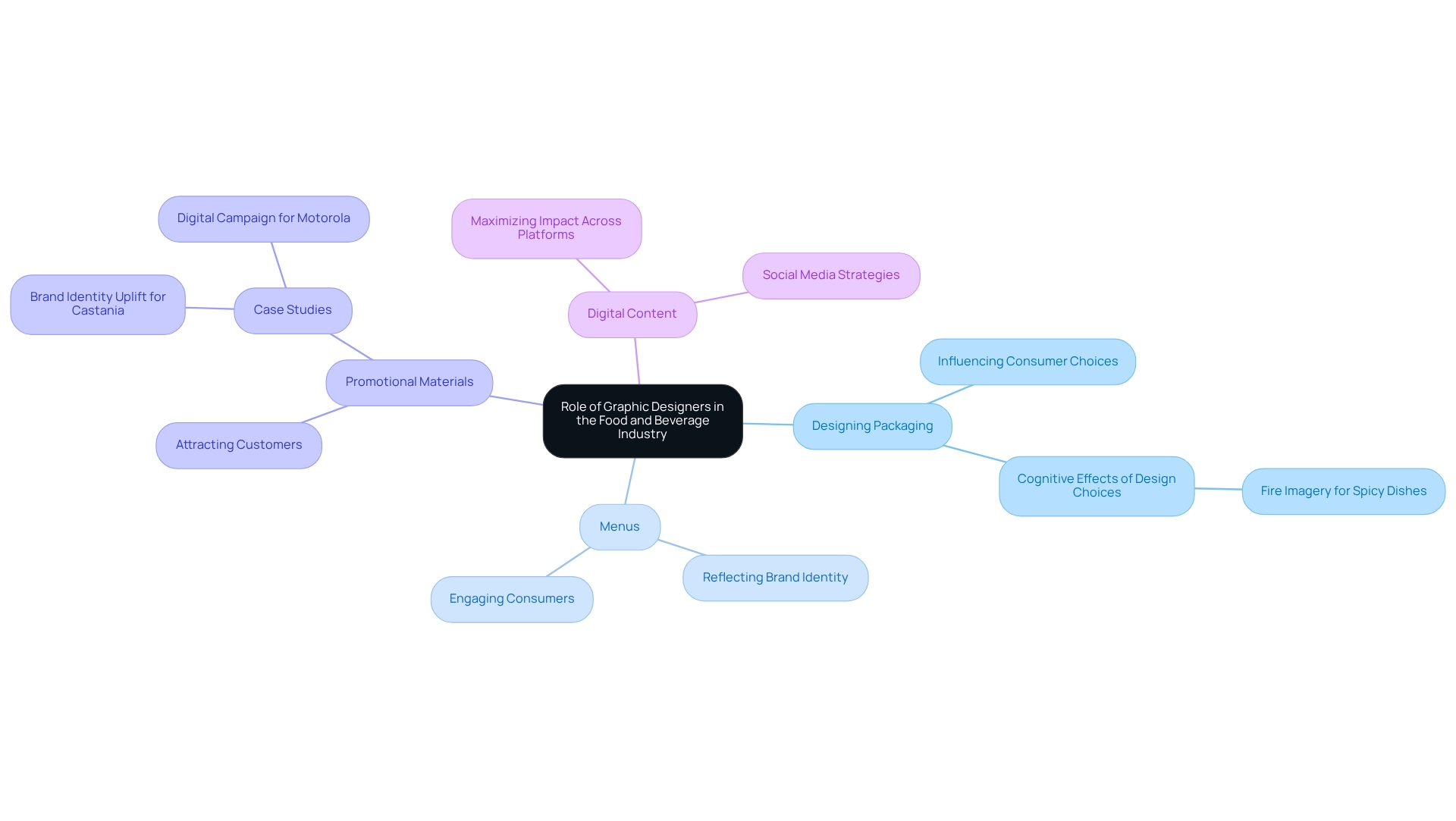
Current Compensation Trends for Graphic Designers in 2024
In 2024, graphic designer compensation in the food and beverage sector is projected to range from $45,000 to $90,000, influenced by factors such as experience and geographic location. Entry-level positions typically commence at around $40,000, whereas mid-level professionals can expect to earn between $55,000 and $70,000. Senior designers and those in specialized roles often command salaries exceeding $85,000, reflecting their advanced skills and significant contributions to branding initiatives.
The demand for adept visual artists is on the rise, particularly in metropolitan areas where living costs are elevated, prompting companies to present more competitive compensation packages for graphic designers in 2024 within the food and beverage sector. Notably, the Northwest Colorado nonmetropolitan region stands out as the highest-paying area for visual creators, offering an average hourly wage of $34.54, a crucial consideration for brand managers evaluating geographic salary influences.
Freelance designers in this domain have the flexibility to establish hourly rates that vary widely, typically between $25 and $100, contingent upon their expertise and the complexity of the projects they undertake.
As the culinary and beverage sector grapples with a long-term success rate of only 20%, as noted by Ray Delucci, a graduate of The Culinary Institute of America, the importance of visual creators intensifies in crafting compelling brand narratives and visual identities that resonate with consumers. Effective branding is indispensable for navigating the challenges of this competitive landscape. Noteworthy case studies, such as the extensive campaigns developed for Mirinda and Quaker Oats by WonderEight, illustrate how impactful design can enhance brand visibility and fortify consumer relationships, ultimately contributing to a brand’s success and justifying higher salaries for talented professionals.
WonderEight’s innovative branding strategies not only elevate the visual appeal of products but also play a pivotal role in shaping consumer perceptions, thereby enhancing the overall value of design within the culinary and beverage industry.
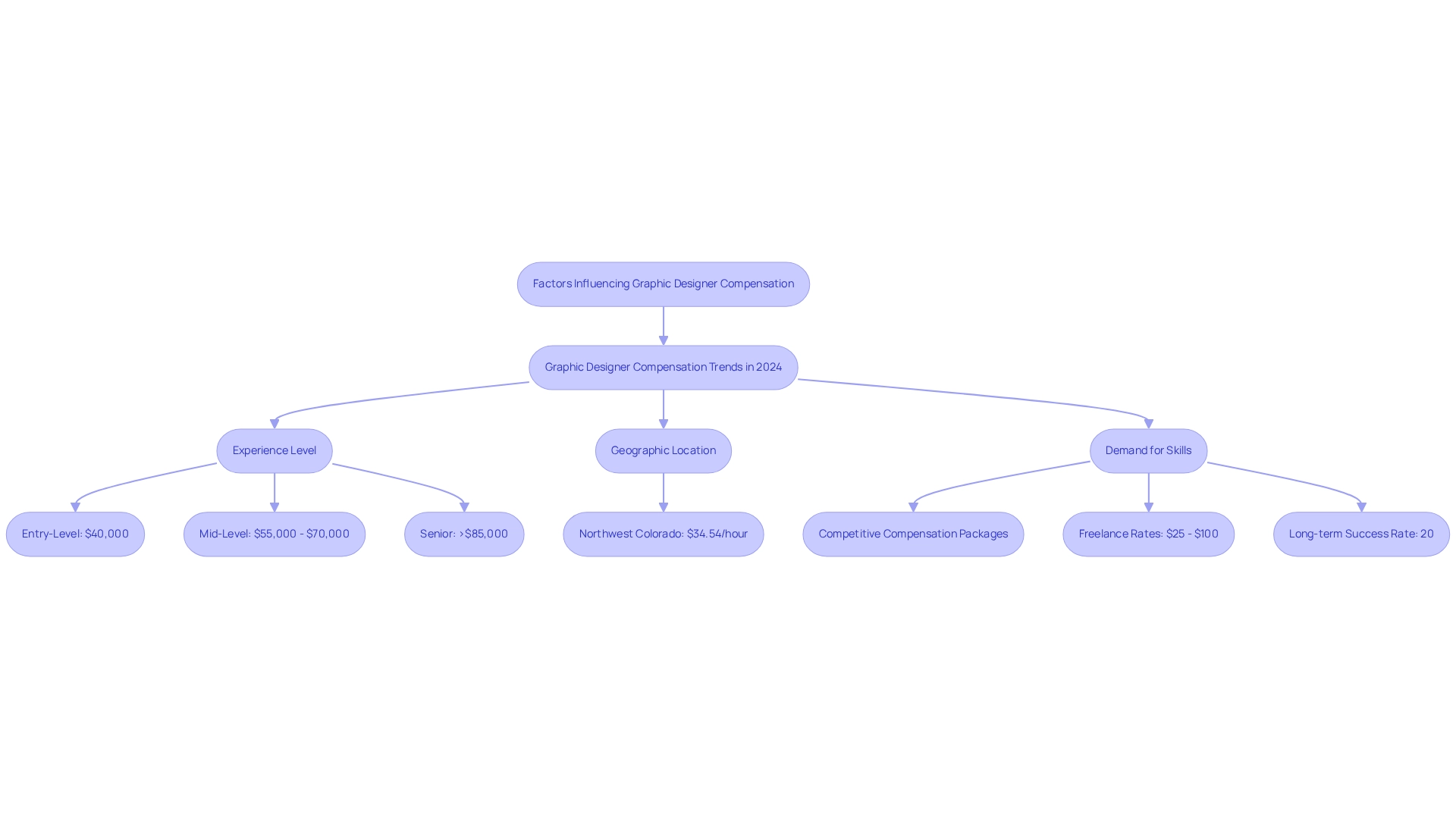
Key Factors Affecting Graphic Designer Salaries
Several key factors significantly influence graphic artist salaries within the food and beverage sector.
-
Experience is paramount; graphic artists with greater expertise typically command higher salaries. While entry-level professionals may begin with lower compensation, those with over five years in the field often see substantial salary increases that reflect their enhanced skills and industry knowledge.
-
Location also plays a crucial role in salary variation. Designers situated in major metropolitan areas frequently earn more due to elevated living costs and a higher demand for design services. For instance, in the UAE, the competitive landscape of cities like Dubai and Abu Dhabi can lead to increased pay for visual designers.
-
Industry Demand is another critical factor. The food and beverage sector is particularly competitive, with professionals possessing specialized skills—such as expertise in packaging design or digital marketing—likely to earn higher salaries. This trend is indicative of the 2024 graphic designer compensation landscape in this sector, driven by the need for innovative branding strategies that resonate with consumers. The growth of digital media and the necessity for online resources have further intensified the demand for visual creators. For example, WonderEight’s successful campaigns for brands like Mirinda and Quaker Oats not only enhanced brand visibility and consumer connection but also underscore the significance of specialized skills in this competitive market.
-
Education and Skills are vital as well. A designer’s educational background and skill set greatly impact earning potential. Designers holding advanced degrees or certifications in visual design or related fields often find better opportunities for higher salaries. Furthermore, proficiency in industry-standard software, such as Adobe Creative Suite, is essential for success in this sector, further influencing salary levels.
According to recent statistics, the hourly average pay for visual creators stands at $44.11, culminating in an annual average income of $91,750. Understanding these elements can empower brand managers and companies to navigate the complexities of employing and compensating visual artists effectively, particularly concerning the 2024 graphic designer compensation in the food and beverage sector.

Essential Skills and Qualifications for Higher Compensation
To secure higher compensation in the competitive landscape of graphic design, particularly within the food and beverage sector, designers must prioritize the development of essential skills:
- Proficiency in Design Software: Mastery of industry-standard tools such as Adobe Photoshop, Illustrator, and InDesign is vital. Skilled creators produce high-quality visuals that meet client expectations and industry standards, directly impacting their marketability and salary potential.
- Understanding of Branding: A solid grasp of branding principles enables creators to craft cohesive visual identities that resonate with consumers. This knowledge is crucial in the food and beverage industry, where brand perception significantly influences purchasing decisions.
- Digital Marketing Skills: Familiarity with digital marketing strategies, including social media management and content marketing, enhances an individual’s value. As brands increasingly depend on digital platforms to connect with consumers, creatives who can incorporate marketing insights into their work are in high demand.
- Project Management: Skills in project management and team collaboration can pave the way for leadership roles, which often come with higher salaries. Efficient project management guarantees that design projects are completed punctually and within budget, demonstrating a professional’s capability to deliver results.
- Continuous Learning: The design industry is constantly evolving, making it crucial for visual communicators to stay informed about the latest trends and technologies. Engaging in ongoing education not only enhances skill sets but also positions professionals as valuable assets in a rapidly changing market.
The Middle East design market represented roughly 2% of the global market in 2024 and is undergoing swift expansion fueled by technological advancements and cultural diversity, particularly in the hospitality sector. This growth presents encouraging prospects for graphic artists to make a substantial impact, especially for those possessing the skills listed earlier. Notable success stories, such as the brand identity uplift for Castania and the digital campaign for Motorola, underscore the importance of these skills in achieving measurable outcomes and ultimately influencing 2024 graphic designer compensation in the food and beverage sector.
As Robert Galinski, Global Cruise Segment Director, notes, “The integration of design and marketing insights is crucial for brands looking to thrive in today’s competitive landscape.
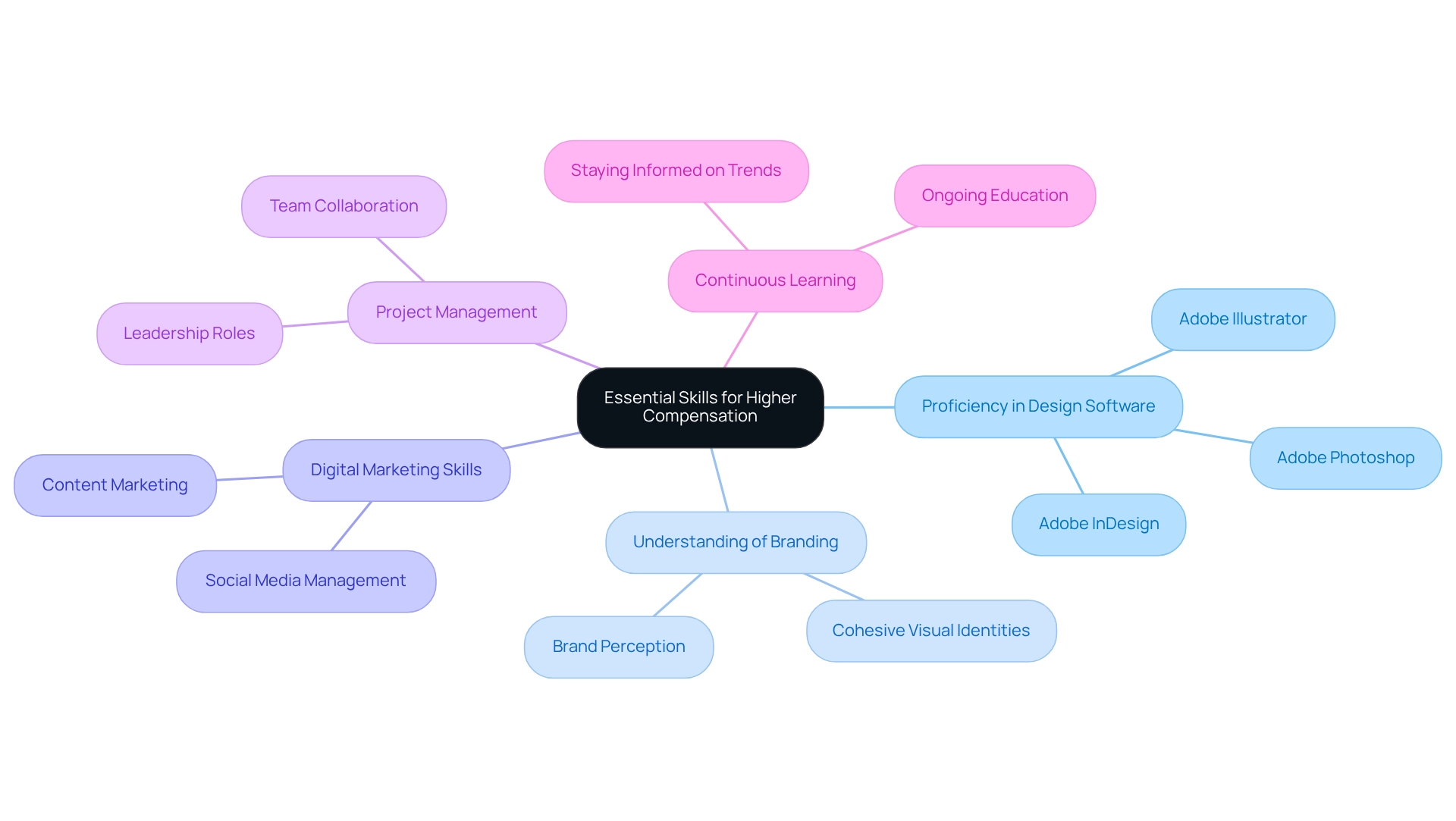
Employment Types and Their Impact on Compensation
Graphic designers in the food and beverage industry have the opportunity to explore various employment types, each distinguished by unique compensation structures:
-
Full-Time Employment: This option typically offers a stable salary along with benefits and job security. Salaries for full-time professionals generally range from $50,000 to $80,000, influenced by factors such as experience and specific skill sets. For comparative perspective, the salary range for graphic artists in Sydney falls between AU$46,000 and AU$76,000.
-
Freelance Work: Freelancers enjoy the flexibility to set their own rates, which can lead to higher earnings, particularly for specialized projects that require unique expertise. However, this employment type often comes with the trade-off of lacking benefits and job security, making it essential for freelancers to manage their finances meticulously. Personal fulfillment and work-life balance are also significant factors in a successful design career, which freelancers often prioritize.
-
Contract Positions: Contract roles frequently provide higher hourly rates compared to full-time positions, appealing to those aiming to maximize their earnings. While these roles may not offer benefits, they present valuable opportunities for creators to gain diverse experience across various companies and projects.
-
Internships: Although internships typically offer lower pay, they are critical for acquiring hands-on experience and can serve as a stepping stone to full-time employment. Many successful creators initiate their careers through internships, which can lead to permanent positions within the industry.
A notable example of effective branding strategies impacting compensation and career opportunities is WonderEight’s comprehensive campaign for Quaker Oats, which resonated with health-conscious consumers and enhanced the brand’s market presence. This campaign not only boosted brand loyalty and sales but also underscored the potential for creators to engage in impactful projects that can elevate their careers.
For those seeking to enhance their skills, courses available on Coursera, such as Effective Communication: Writing, Design, and Presentation Specialization and Design and Make Infographics, can be instrumental in developing both technical and interpersonal skills.
As Alison Cook, an artist and illustrator, reflects, “I work for a charity near Winchester, instead of in advertising in London,” highlighting the diverse paths available within the design field. Understanding these job categories is crucial for visual artists in the culinary industry, as it significantly impacts the 2024 graphic designer compensation in the food and beverage sector and their career trajectory. As the industry evolves, staying informed about these dynamics will assist professionals in making strategic career decisions.
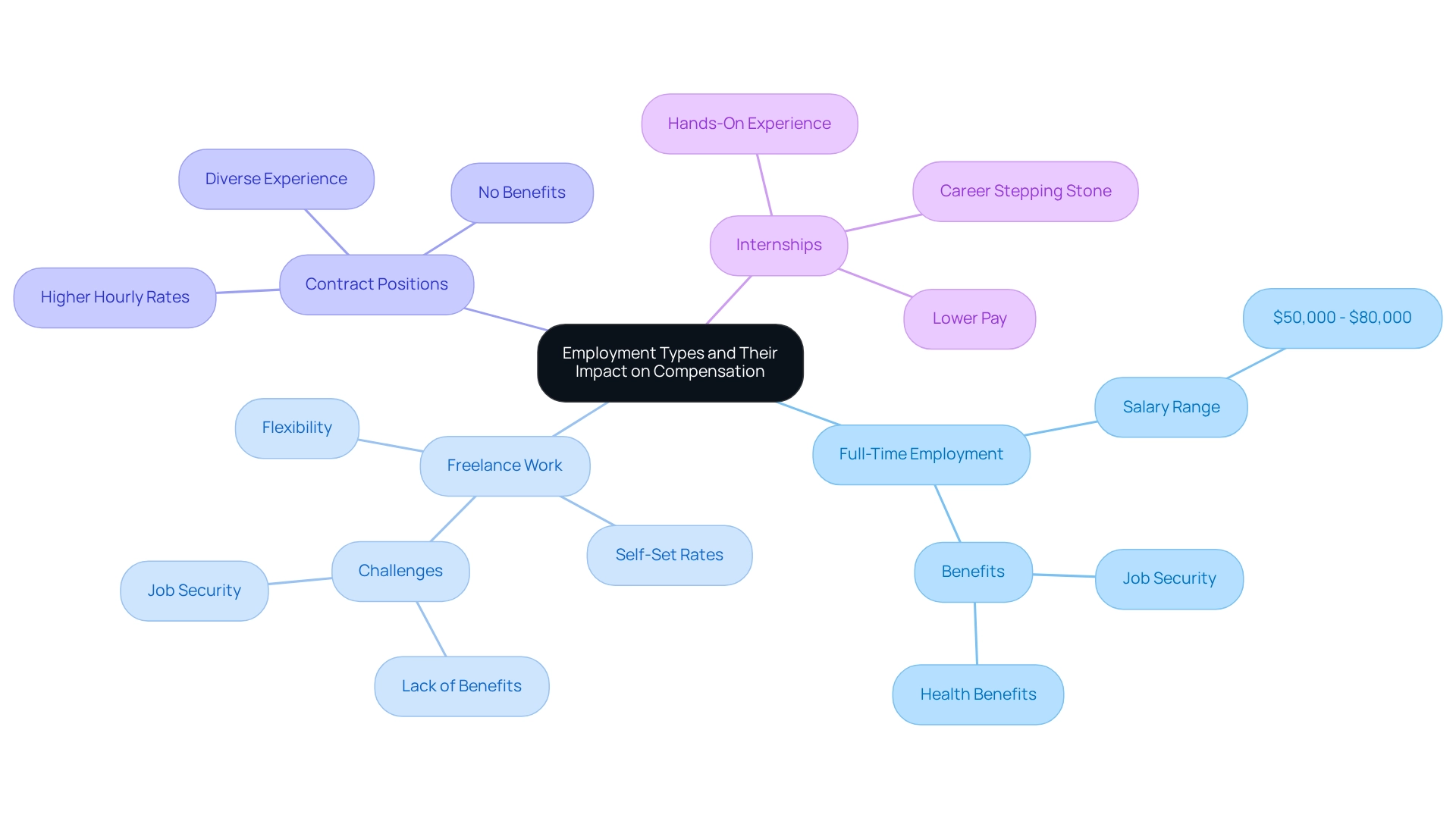
Understanding Benefits and Perks in Graphic Design Roles
Beyond salary considerations, graphic designers in the food and beverage industry must meticulously assess the array of benefits and perks associated with their roles, as these factors can significantly elevate their overall compensation package:
-
Health Insurance: Comprehensive health insurance serves as a cornerstone of full-time employment, offering essential financial protection against medical expenses. This advantage not only bolsters physical well-being but also contributes to job satisfaction, as individuals feel valued and secure in their positions.
-
Retirement Plans: Numerous employers provide retirement savings plans, such as 401(k) matching, which can substantially enhance long-term financial security. By actively contributing to these plans, graphic artists can secure a more stable future, making this benefit a critical component of their overall compensation.
-
Flexible Work Arrangements: The demand for remote work or flexible hours is increasingly prominent in today’s job market. Such arrangements can greatly improve work-life balance, enabling individuals to manage their personal and professional lives more effectively, a necessity in the fast-paced food and beverage sector.
-
Professional Development: Opportunities for ongoing training and skill enhancement are vital for career progression. As Hendrik N. J. Schifferstein noted, ‘Being a design thinker and a creator at the same time really helps to speak these different languages and know when somebody is useful.’ Employers who invest in their employees’ professional development not only foster loyalty but also equip individuals with the necessary resources to advance in their careers and potentially increase their earnings.
-
Paid Time Off: Generous vacation days and sick leave are crucial for maintaining mental health and job satisfaction. Designers with access to adequate paid time off are more likely to return to work refreshed and motivated, ultimately benefiting their creativity and productivity.
In 2024, the emphasis on these benefits is anticipated to intensify, particularly concerning graphic designer compensation in the food and beverage sector, as companies recognize their pivotal role in attracting and retaining top talent within the competitive industry. The integration of health insurance and retirement plans into compensation packages is especially crucial, as studies indicate a strong correlation between job satisfaction and the availability of these benefits. Furthermore, with the worldwide visual design sector market size projected at $43.4 billion by 2025, understanding the complete spectrum of remuneration—including these essential benefits—will empower visual creators to make informed decisions that align with their career and personal aspirations.
Moreover, the statistic that the brain processes images 60,000 times faster than text underscores the significance of visual communication in visual design, reinforcing the importance of the benefits discussed. As visual artists navigate their career paths, recognizing the value of collaboration, akin to the integrative role of chefs in culinary product development, can further enhance their contributions in the culinary sector.
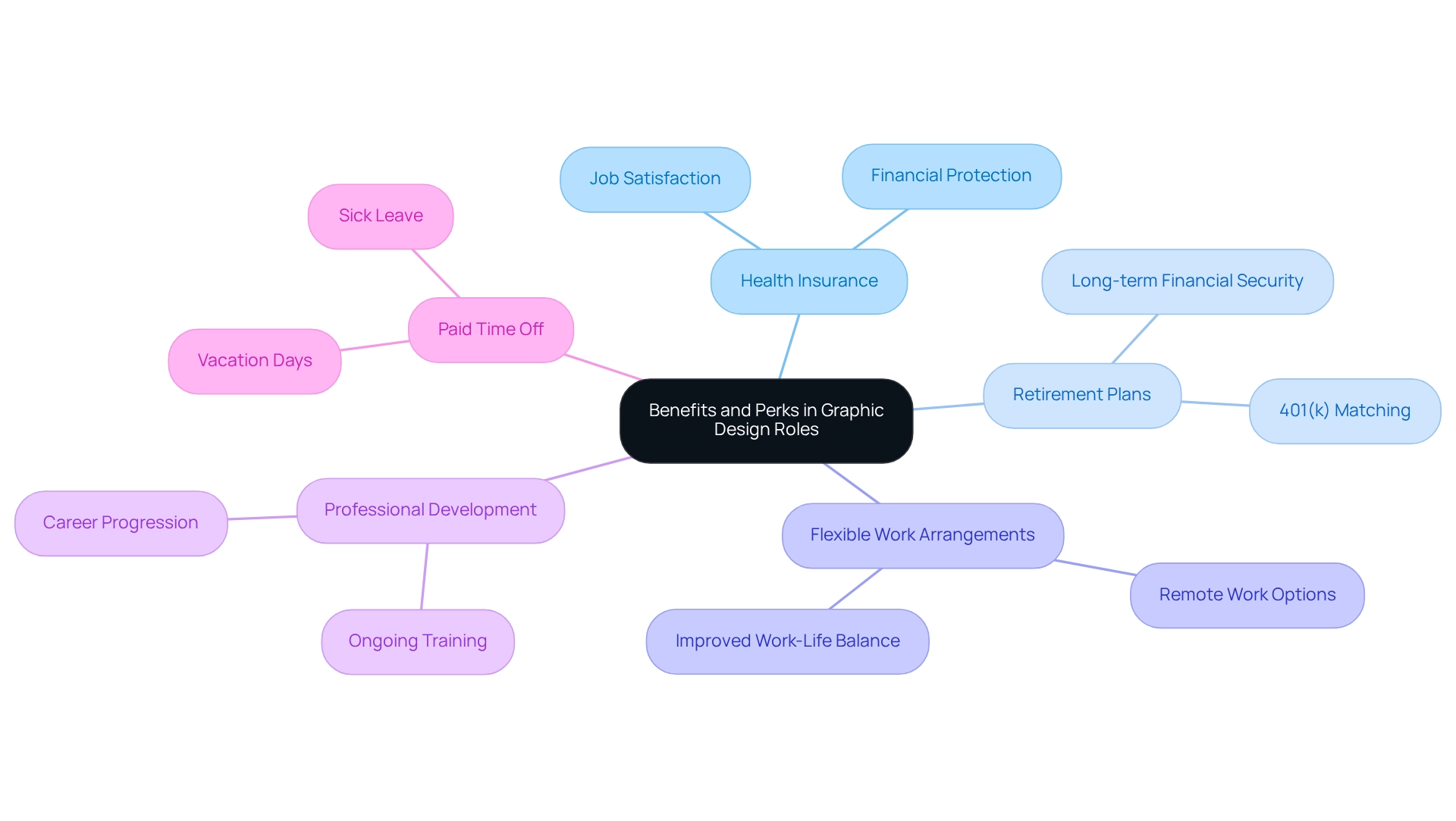
Networking and Professional Development: Keys to Higher Earnings
To maximize earning potential, graphic artists in the UAE food and beverage sector must focus on networking and professional growth, especially considering the projected graphic designer compensation for 2024. Here are key strategies to implement:
-
Join Professional Organizations: Becoming a member of design associations grants access to valuable resources, job boards, and networking events that can open doors to new opportunities. Notably, 30% of industry respondents engage with external customers or the public, underscoring the critical role of networking in enhancing earning potential.
-
Attend Industry Conferences: Participation in conferences provides creators with the chance to connect with industry leaders, stay updated on trends, and showcase their portfolios to a wider audience.
-
Utilize Social Media: Platforms such as LinkedIn and Instagram serve as effective tools for networking and displaying work, enabling creatives to successfully connect with potential clients and collaborators.
-
Seek Mentorship: Building a relationship with a mentor in the industry can offer invaluable guidance, support, and essential connections that facilitate career advancement.
-
Continuous Learning: Engaging in workshops, online courses, and obtaining certifications not only sharpens skills but also boosts marketability, making professionals more competitive in the job market. As Alison Cook, an artist and illustrator, reflects, “My salary is now what it was in 2005. But my work life is much richer and more fulfilling,” emphasizing the significance of job satisfaction.
Moreover, a case study titled ‘Work-Life Balance vs. Salary’ reveals that while salary is important, professionals in the field should also consider the overall quality of their work life and personal satisfaction when evaluating their careers.
By prioritizing these strategies, graphic artists can significantly enhance their professional profiles and increase their earning potential, particularly in relation to the 2024 graphic designer compensation within the food and beverage sector.

Summary of Key Insights on Graphic Designer Compensation
Graphic creators in the food and beverage sector can anticipate a diverse salary range, shaped by factors such as experience, geographic location, and market demand. This will be evident in the 2024 graphic designer compensation landscape within this sector. The compensation reflects a growing emphasis on specialized skills; professionals with expertise in digital marketing and branding strategies are commanding higher salaries. Employment type also plays a pivotal role: freelance professionals may encounter income variability based on project availability, whereas full-time positions typically offer greater stability and benefits.
Key factors impacting graphic designer salaries include:
- Skill Set: Proficiency in design software, a solid grasp of branding principles, and experience with digital marketing tools are highly sought after.
- Location: Designers situated in major urban centers, particularly those with vibrant culinary and beverage cultures, tend to earn more due to elevated living costs and heightened demand for creative talent.
- Industry Demand: The food and beverage sector is evolving, evidenced by a remarkable 52% increase in dessert concept openings from May 2023 to April 2024. This trend signifies a robust market and may influence 2024 graphic designer compensation for innovative branding and design.
To enhance earning potential, professionals should prioritize developing essential skills, actively engage in networking opportunities, and pursue ongoing professional development. Understanding the complete compensation package—including benefits such as health insurance, retirement plans, and flexible working arrangements—is vital for making informed career decisions.
Furthermore, insights from recent salary studies reveal that only 4% of restaurants currently accept payments via Venmo, highlighting a gap in digital payment adoption that savvy creators can leverage to craft compelling branding strategies. As Ray Delucci notes, “The restaurant success rate for long-term stability is around 20%,” underscoring the challenges faced by the industry.
In this competitive landscape, WonderEight’s innovative branding and digital marketing solutions can significantly influence a creator’s earning potential. By devising effective branding strategies, professionals can help businesses distinguish themselves, potentially leading to increased 2024 graphic designer compensation in the food and beverage sector. Notable client success stories, such as the brand identity uplift for Castania and the digital campaign for Motorola, further illustrate the effectiveness of strategic branding in achieving measurable outcomes.
As the industry continues to evolve, staying abreast of these trends will be crucial for graphic designers aiming to thrive in the competitive food and beverage landscape.
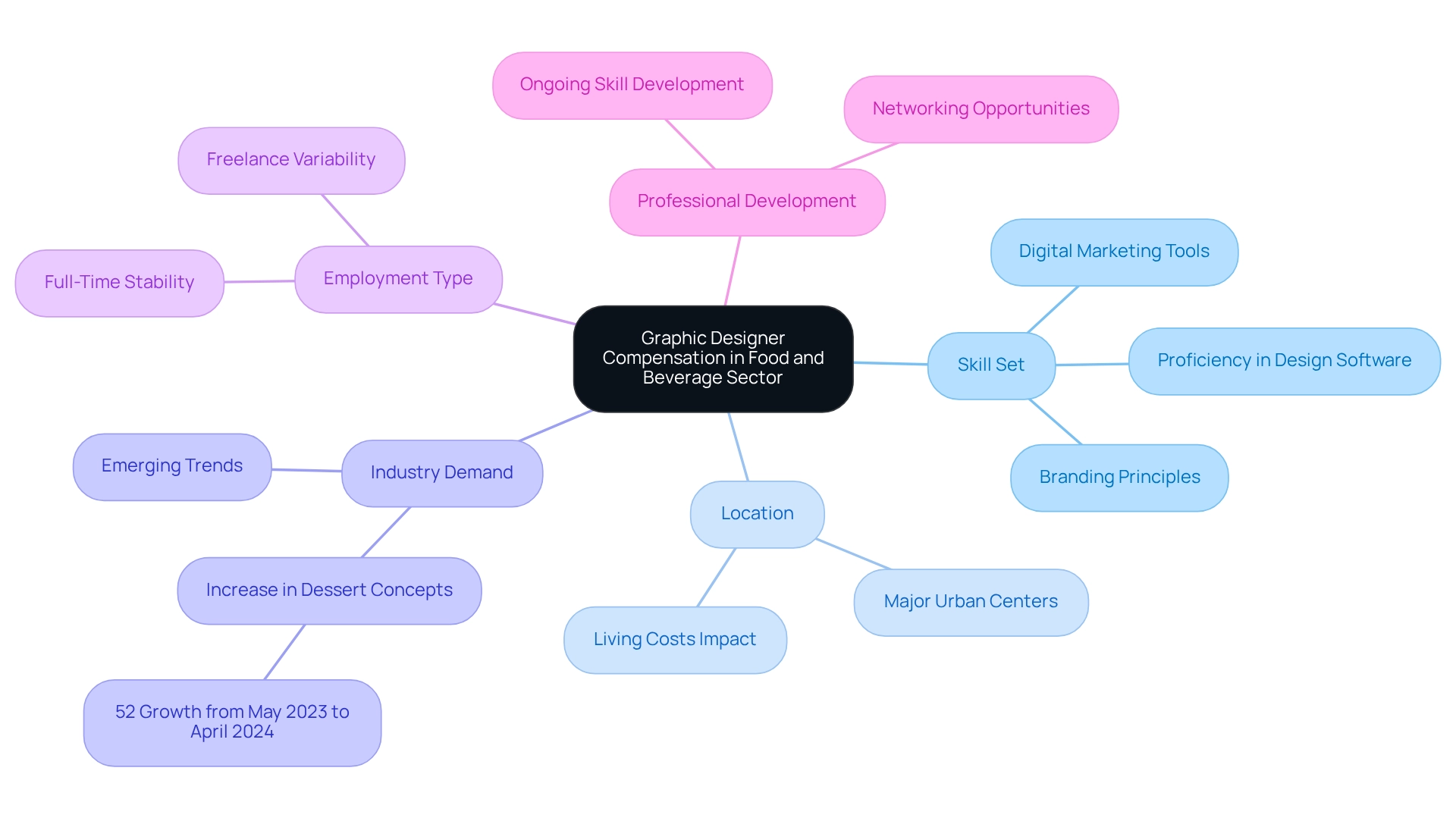
Conclusion
Graphic designers play a pivotal role in the food and beverage industry, crafting visual narratives that not only shape brand identities but also influence consumer choices. Their expertise in designing packaging, menus, and promotional materials directly addresses the evolving consumer preferences and trends that define this dynamic sector.
As of 2024, salaries for graphic designers within this field range from $45,000 to $90,000, influenced by factors such as experience, location, and the demand for specialized skills in digital marketing and branding. Full-time positions typically offer greater stability and benefits, whereas freelance roles provide flexibility, albeit with the potential for variable income.
To excel in this competitive landscape, designers must prioritize:
- Skill enhancement
- Networking
- A commitment to continuous learning
Mastery of design software, a robust understanding of branding, and the ability to integrate marketing insights are essential for increasing marketability and maximizing earning potential. Furthermore, recognizing the value of benefits such as health insurance and retirement plans can significantly elevate job satisfaction.
As the food and beverage industry continues to evolve, staying abreast of trends and leveraging design skills to develop innovative branding strategies will be crucial. By assisting businesses in differentiating themselves, graphic designers can attain greater success and enhanced compensation. Ultimately, the role of a graphic designer transcends mere financial gain; it embodies the fulfillment derived from making a meaningful impact in a vibrant industry.
Frequently Asked Questions
What role do visual artists play in the culinary and beverage sector?
Visual artists in the culinary and beverage sector are crucial for crafting visual narratives that convey brand identity and engage consumers. Their responsibilities include designing packaging, menus, promotional materials, and digital content, all aimed at attracting customers while encapsulating the brand’s essence.
How does effective graphic design influence consumer choices?
Effective graphic design can significantly sway consumer choices, making it an essential element of marketing strategies. It helps in creating engaging visuals that resonate with target audiences, particularly in the context of evolving eating habits.
What factors influence graphic designer compensation in 2024?
In 2024, graphic designer compensation in the food and beverage sector is projected to range from $45,000 to $90,000, influenced by factors such as experience, geographic location, and the complexity of projects. Entry-level positions start around $40,000, while senior designers may earn over $85,000.
Where are the highest-paying areas for graphic designers in this sector?
The Northwest Colorado nonmetropolitan region is noted as the highest-paying area for visual creators, offering an average hourly wage of $34.54.
What are the typical hourly rates for freelance graphic designers?
Freelance graphic designers typically set their hourly rates between $25 and $100, depending on their expertise and the complexity of the projects they undertake.
Why is effective branding important in the culinary and beverage sector?
Effective branding is vital for navigating the competitive challenges of the culinary and beverage sector, where long-term success rates are low. Visual creators help craft compelling brand narratives and visual identities that resonate with consumers, enhancing brand visibility and fortifying consumer relationships.
Can you provide examples of successful visual design projects in this industry?
Noteworthy case studies include branding initiatives for Castania and digital campaigns for Motorola, illustrating how strategic visual elements can lead to measurable outcomes, enhancing brand visibility and consumer interaction.
How do visual artists contribute to the marketing landscape in the culinary sector?
Visual artists not only shape consumer perceptions but also play a pivotal role in the broader marketing landscape by fostering sector growth and supporting emerging talents through effective visual design and branding strategies.


